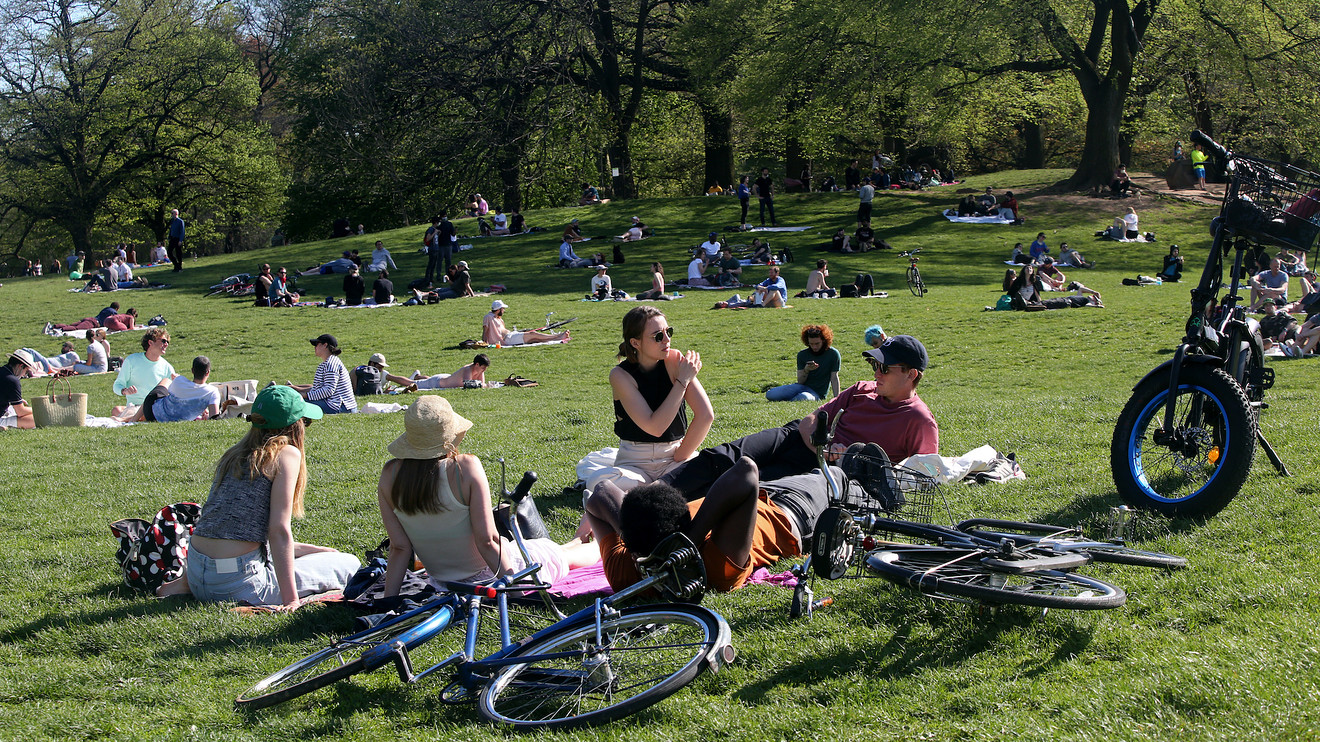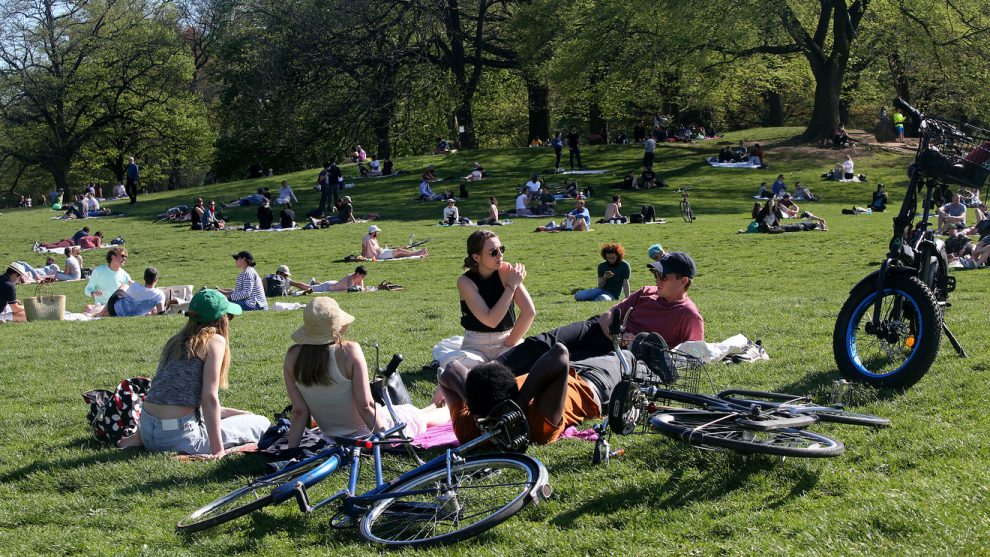
New Yorkers flocked to parks and outdoor spaces this past weekend as the mercury topped 70 degrees Fahrenheit in the city, but the crowds raise serious questions about how officials will enforce stay-at-home orders for weeks to come.
On Monday morning, Mayor Bill de Blasio took the opportunity to remind people of the necessity of continued diligence in the fight against coronavirus. The warmer weather “makes us start to think maybe things are even a little better than the facts suggest, and that’s why we have to always keep our balance,” de Blasio said. “Be hopeful, be inspired, be diligent, keep doing what we have to do.”
The mayor’s reminder came alongside increasingly optimistic data points: declining numbers of people admitted to hospitals for suspected COVID-19; declining numbers of COVID-19 patients in ICUs across public hospitals and declining numbers of individuals testing positive for the virus.
In New York City as of Monday afternoon, 170,534 people have tested positive for the coronavirus, 13,536 have died, with another 5,373 deaths suspected to be due to the virus, according to the city’s health department. For the first time in weeks, less than 100 people walked into hospitals with suspected cases of COVID-19 in a single day, de Blasio said citing Saturday’s figures.
Despite the improvements and the weekend crowds, New York City is on track to be one of the last regions in the state to reopen, if data Gov. Andrew Cuomo released Monday is any indication.
The governor laid out seven criteria regions of the state must meet in order to phase in reopening on May 15, when stay-at-home orders, known as New York on Pause, will expire. They include: 14 consecutive days of declining hospitalizations and deaths on a three-day rolling average; fewer than two new hospitalizations per 100,000 residents; 30% of hospital beds and specifically intensive care beds available; 30 per 1,000 residents tested on a seven-day average; and at least 30 contact tracers per 100,000 residents.
See: New York City ramps up tracing and introduces ‘self-swab tests’
As of Monday, none of the state’s 10 regions met those strict criteria, but some are much closer than others. New York City, where hospitals are still above 80% capacity and many people are still walking into emergency rooms with suspected COVID-19, met only three of the seven criteria: declining hospitalizations and deaths, and adequate testing. Long Island is the only region of the state behind the city.
“If upstate has to wait for downstate to be ready, they’re going to be waiting a long time,” Cuomo said. Statewide, there were 2,538 new lab-confirmed cases of the virus and 226 deaths on Sunday, down from a peak of 799 deaths in a single day in April.
The governor said he supported ticketing those who flout social distancing guidelines, including wearing masks in public. But it was up to municipalities and local law enforcement agencies to come up with penalties and enforce them, he said.
Meanwhile, de Blasio pledged to distribute 7.5 million face coverings across New York City in locations including parks, public housing developments, grab-and-go food sites being run out of schools, at Mitchell-Lama affordable housing buildings and at the Staten Island ferry.
“Any place that the NYPD and the Parks Department and other agencies are going to enforce social distancing, they’ll also be carrying a supply of free face coverings,” de Blasio said. “It’s going to make things easier and easier for New Yorkers who want to follow these rules and want to keep people safe.”
Nevertheless, this past weekend was “particularly challenging,” according to New York City Police Commissioner Dermot Shea, who, during Monday’s mayoral briefing noted that going forward, the NYPD would make adjustments both in deployment as well as messaging.
More than 1,000 NYPD officers were deployed citywide to ensure social distancing, and issued 89 summonses for such infractions, according to an NYPD news release.
“Every week we’ll get better in terms of the ability to enforce,” de Blasio said, adding that the process will be helped by the increasing numbers of personnel returning to work from being out sick. At the moment, violators in the city could pay a maximum fine of $1,000.
“We are going to make sure that social distancing works,” he said. “That’s our pathway back to normal. It has to work. We have to make it work, but it requires enforcement to do that.”
But images of New Yorkers flouting social distancing protocols over the weekend raised concerns about exactly how the rules were going to be enforced as the weather gets nicer and whether there’s a racial bias among those responsible for enforcement, said Jumaane Williams, the city’s public advocate at a briefing on Monday.
Images on social media of crowds of mostly white people—many without face coverings—gathering undisturbed at a riverside pier in the West Village contrasted sharply with a video also taken over the weekend that showed a violent confrontation on the Lower East Side between a cop enforcing social distancing with a young black man.
“We had a feeling that there was not equity in enforcement,” Williams said. “Just like COVID and corona is magnifying structural inequities in communities, it’s not creating new ones, it’s magnifying the ones that exist. It’s also magnifying problems in leadership and problems in policing.”
Williams is calling on the mayor to provide a better breakdown of the people being summoned and arrested for social distance infractions.
Also read: Anxiety about prejudice during coronavirus remains for Asian-American leaders in New York City
Police enforcement “has to be equitable,” Williams said.
“You can’t have pictures of people handing masks in one community and not even questioning why people don’t have masks on,” he added, “and then in another, people getting punched to the ground.”











Add Comment